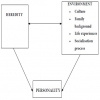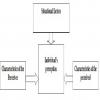Home | ARTS | Management Concepts & Organisational Behaviour
|
Principle of Reinforcement - Perception And Learning
Management Concepts & Organisational Behaviour - Perception And Learning
Principle of Reinforcement - Perception And Learning
Posted On :
We understand that some behaviours are strengthened by the process of reinforcement.
Principle
of Reinforcement
We understand that some behaviours are strengthened by the process of reinforcement. Reinforcer may be any stimulus that prompts a behaviour to be repeated or stopped. Managements expect that the employee should behave in a desirable manner in the organization and avoid undesirable behaviour. By the appropriate use of reinforcers, the organizations are able to maintain or increase the probability of behaviours like quality oriented performance, wise decision making, regular attendance and punctuality and so on. Some reinforcers work by their application to a situation whereas other reinforcers work by their removal from this situation.
Positive reinforcement is provided by offering rewards for desired behaviours. Such rewards should be powerful and durable so as to increase the probability of occurrence of desirable behaviour. Money, as you understand, is the most powerful reinforcement for positive behaviour since money can be used for a number of other purposes. Some other positive reinforcers are recognition for good performance, challenging task, participation in decision making and so on. As individuals have different motivations of performance, positive reinforcers should be individually tailored with a view to facilitate the repetition of desired behaviour. That means reinforcer must be valued by the employee. For example, money would be a less reinforcer who values praise for his performance more. The reward must be directly linked with behaviour so that the higher the performance of an employee, the grater would be the reward.
In negative reinforcement, an unpleasant event that precedes the employee behaviour is removed when the desired behaviour occurs. This procedure increases the likelihood of the desired behaviour to follow. Negative reinforcement is sometimes confused with punishment because both use unpleasant events to influence behaviour. However, negative reinforcement is used to increase the frequency of a desired behaviour, whereas punishment is used to decrease the frequency of an undesired behaviour. Managers frequently use negative reinforcement when an employee hasn’t done something that is desired.
Omission is the removal of all reinforcing events. While reinforcement increases the frequency of a desirable behaviour, omission decreases the frequency and eventually extinguishes an undesirable behaviour. Managers use omission to reduce undesirable employee behaviours that obstruct achievement of organizational goals. The omission procedure consists of three steps.
1. identifying the behaviour to be reduced or eliminated,
2. identifying the reinforcer that maintains the behaviour, and
3. stopping the reinforcer.
Omission is a useful technique for reducing and eventually eliminating behaviours that disrupt normal workflow.
Punishment is an unpleasant event that follows a behaviour and decreases its frequency. As in positive reinforcement, a punishment may include a specific antecedent that cues the employee that a consequence will follow a specific behaviour. While a positive consequence of reinforcement encourages the frequency of a desired behaviour, a consequence of punishment decreases the frequency of an undesired behaviour.
Organizations typically use several types of unpleasant events to punish individuals. They may be a wage cut, a suspension without pay, a demotion, or a transfer. The severe punishment is the dismissing an employee for failure to perform. In general, organizations use punishments of unpleasant nature sparingly for cases of serious behavioural problems.
It may be kept in mind that punishment should be used as a lost resort. The use of punishment should be limited to those undesirable behaviours that cause a significant damage to the organizational operations. It may also be remembered that punishment should not lead to hostility to such an extent of making solution more harmful than the problem itself.
Punishment may cause undesirable emotional reactions. An employee who has been reprimanded for a mistake may react with anger toward the manager and the organization. Such reactions may lead to retaliatory behaviour harmful to the organization. Sabotage, you remember, typically is a result of a punishment-oriented management system. It is clear that punishment leads to short-term suppression of the undesirable behaviour, rather than to its elimination. Further, the punished individual may develop a tendency of avoiding the situation. High absenteeism is a form of avoidance and quitting is the final form of escape.
We understand that some behaviours are strengthened by the process of reinforcement. Reinforcer may be any stimulus that prompts a behaviour to be repeated or stopped. Managements expect that the employee should behave in a desirable manner in the organization and avoid undesirable behaviour. By the appropriate use of reinforcers, the organizations are able to maintain or increase the probability of behaviours like quality oriented performance, wise decision making, regular attendance and punctuality and so on. Some reinforcers work by their application to a situation whereas other reinforcers work by their removal from this situation.
Positive Reinforcement
Positive reinforcement is provided by offering rewards for desired behaviours. Such rewards should be powerful and durable so as to increase the probability of occurrence of desirable behaviour. Money, as you understand, is the most powerful reinforcement for positive behaviour since money can be used for a number of other purposes. Some other positive reinforcers are recognition for good performance, challenging task, participation in decision making and so on. As individuals have different motivations of performance, positive reinforcers should be individually tailored with a view to facilitate the repetition of desired behaviour. That means reinforcer must be valued by the employee. For example, money would be a less reinforcer who values praise for his performance more. The reward must be directly linked with behaviour so that the higher the performance of an employee, the grater would be the reward.
Negative Reinforcement
In negative reinforcement, an unpleasant event that precedes the employee behaviour is removed when the desired behaviour occurs. This procedure increases the likelihood of the desired behaviour to follow. Negative reinforcement is sometimes confused with punishment because both use unpleasant events to influence behaviour. However, negative reinforcement is used to increase the frequency of a desired behaviour, whereas punishment is used to decrease the frequency of an undesired behaviour. Managers frequently use negative reinforcement when an employee hasn’t done something that is desired.
Omission
Omission is the removal of all reinforcing events. While reinforcement increases the frequency of a desirable behaviour, omission decreases the frequency and eventually extinguishes an undesirable behaviour. Managers use omission to reduce undesirable employee behaviours that obstruct achievement of organizational goals. The omission procedure consists of three steps.
1. identifying the behaviour to be reduced or eliminated,
2. identifying the reinforcer that maintains the behaviour, and
3. stopping the reinforcer.
Omission is a useful technique for reducing and eventually eliminating behaviours that disrupt normal workflow.
Punishment
Punishment is an unpleasant event that follows a behaviour and decreases its frequency. As in positive reinforcement, a punishment may include a specific antecedent that cues the employee that a consequence will follow a specific behaviour. While a positive consequence of reinforcement encourages the frequency of a desired behaviour, a consequence of punishment decreases the frequency of an undesired behaviour.
Organizations typically use several types of unpleasant events to punish individuals. They may be a wage cut, a suspension without pay, a demotion, or a transfer. The severe punishment is the dismissing an employee for failure to perform. In general, organizations use punishments of unpleasant nature sparingly for cases of serious behavioural problems.
It may be kept in mind that punishment should be used as a lost resort. The use of punishment should be limited to those undesirable behaviours that cause a significant damage to the organizational operations. It may also be remembered that punishment should not lead to hostility to such an extent of making solution more harmful than the problem itself.
Punishment may cause undesirable emotional reactions. An employee who has been reprimanded for a mistake may react with anger toward the manager and the organization. Such reactions may lead to retaliatory behaviour harmful to the organization. Sabotage, you remember, typically is a result of a punishment-oriented management system. It is clear that punishment leads to short-term suppression of the undesirable behaviour, rather than to its elimination. Further, the punished individual may develop a tendency of avoiding the situation. High absenteeism is a form of avoidance and quitting is the final form of escape.
You should also note that
punishment suppresses employee initiative and flexibility. Overusing punishment
produces apathetic employees, who are not assets to an organization. Sustained
punishment can also lead to low self-esteem. Low self-esteem, in turn,
undermines the employee’s self-confidence, which is necessary for performing
most of the jobs.
Tags : Management Concepts & Organisational Behaviour - Perception And Learning
Last 30 days 1217 views














